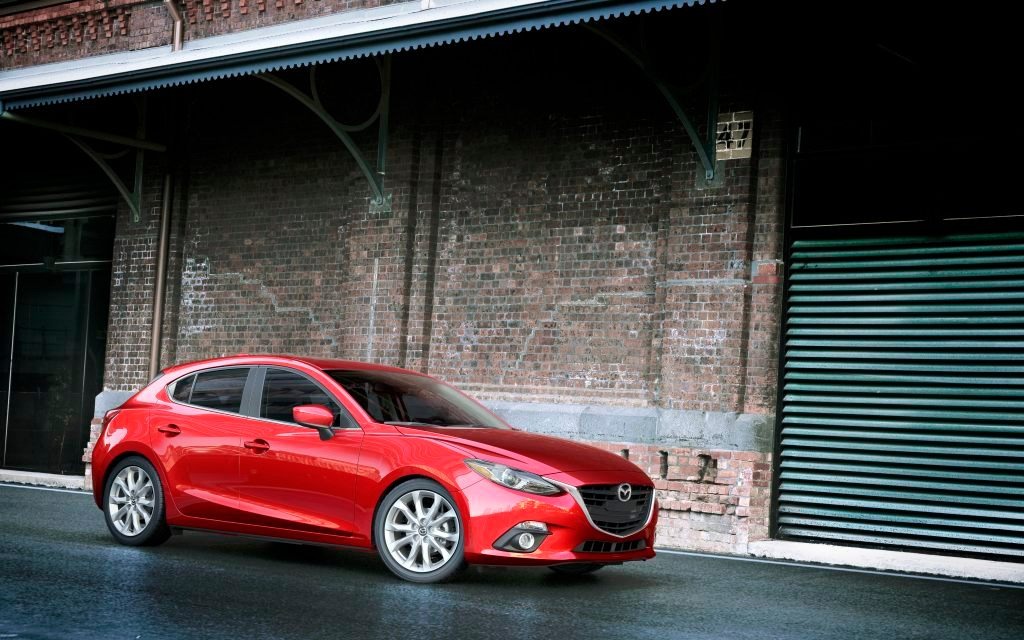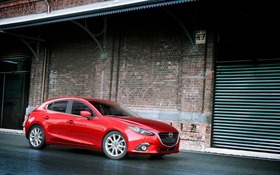2014 Mazda3: Success Is Inevitable
The new generation of Mazda’s popular compact car has just been unveiled at Center 548 in New York’s Chelsea district. And the challenge that lies ahead for this newcomer is significant. With annual sales that account for 30% of Mazda’s total worldwide sales, the Mazda3 is the Hiroshima-based manufacturer’s best-selling model – it goes without saying that this car is extremely important. The release of a new generation comes as no surprise since its overhaul was next up on the manufacturer’s agenda. The CX-5 and Mazda6 got makeovers first, because the company needed a more visible presence in the compact SUV category and the mid-size sedan’s lukewarm sales needed a kick-start. At any rate, the Mazda3’s sales weren’t lagging. On the contrary, the partial inclusion of SKYACTIV technology helped it hold its own against the competition – and then some!
And yet, the family-oriented compact was due for an overhaul. Now, for the first time ever, it will feature a Kodo-inspired design, the full SKYACTIV system and i-ACTIVSENSE, which includes a whole host of active and passive safety features. Note that only the hatchback has been unveiled for the time being – the sedan will come out later.
A winning evolution
Highly successful cars like the Mazda3 represent a nice conundrum for the team developing the next generation. The public is enamored with the vehicle’s current shape, so they know what influences buyers in that regard. But the problem rests therein: you can’t break with the past completely, but you have to move forward with a more modern silhouette, too. Luckily, the Kodo design philosophy helps Mazda introduce changes while conserving a familiar look.
The most radical transformation is with the front grille. Gone is the controversial smiling clown design in favour of a five-point grille whose middle is comprised of black horizontal bars that make the car seem wider than it actually is. Hanging over a large air intake, the grille is underscored by a chrome strip that runs along its bottom edge.
The elliptical headlights stretch toward the rear and the turn signals are located at their edges. The wide stance of the front track gives the car more poise on the road and the reduced overhangs add to its bulldog-ish look. Don’t be fooled: the side panels aren’t arched, but a small ledge along the lower part will make you think they are. And the fact that the back door spills over onto the fender makes it seem more compact and sportier. Add to that the original tail end and its thin horizontal lights, and the Mazda3 can almost pass for an exotic car.
The passenger compartment features better-quality materials, although the previous version was not bad in that department. It is just as stark as the Mazda6, but is seems better organized, perhaps because the vehicle is smaller overall. You get simple, understated and easy-to-access controls combined with impeccable assembly. Meanwhile, the steering wheel, dials and seats look similar to what you find in the CX-5 and Mazda6. Mazda decided to place the LED display screen right on the edge instead of integrating it right into the dash. This new screen shows the vehicle speed, data from the navigation system and other important information on a transparent vertical panel behind the top of the instrument pod. It’s far and away superior to the 2013 version’s minuscule screen. The new instrument panel includes a central analog gauge flanked by wing-shaped digital screens. The central gauge has three-dimensional metal numbering, which highlights the meticulous finish of the passenger compartment. A red ring encircling the central indicator starts to flash as soon as the driver opens the door. The Active Driving Display rises up when the ignition switch is moved to the ON position. Plus, some trims are available with Heads Up Display – a first for this category.
The overall length of both the sedan and hatchback has been reduced compared to before. The vehicle’s height has dropped by 15 mm, while its width is up by 40 mm. The wheelbase has gained a full 60 mm in length. The body is about 90 kg lighter, depending on the trim, while all versions are 30% more rigid.
100 % SKYACTIV
Unlike the version that its replacing, the new 3 comes with a 100% SKYACTIV drivetrain, which means that the engines are now equipped with the 4-2-1 exhaust manifold that was previously sacrificed due to lack of space. The platform is also inspired by the SKYACTIV concept as are the suspension features. That should make it sportier.
In all, four engines will be offered. For North America, the 2.0-litre and 2.5-litre four-cylinder engines are available, and both come factory standard with a six-speed manual gearbox or an optional six-speed automatic. In some other markets, a 1.5-litre four-cylinder and a 2.2-litre diesel are available. For the Japanese market, a hybrid version will be offered for the first time .
The 2.0-litre engine produces 155 horsepower and 150 lbs-ft of torque, while the 2.5-litre generates 184 horsepower and 185 lbs-ft of torque. In both cases, the output should ensure superior performance for the category. Note that it has power steering and that the brakes have been fine-tuned for maximum efficiency and reduced friction. We should mention that an active air shutter placed in front of the radiator opens and closes automatically according to road conditions, thus improving aerodynamics and contributing to improved fuel economy.
There’s more: the i-ELOOP energy regeneration system – a Mazda exclusive – uses a capacitor to store energy produced in deceleration. This improves fuel economy and reduces the amount of electricity required by the engine.
This newcomer doesn’t turn its back on safety either. i-ACTIVSENSE refers to an array of technologies using sensors, like millimetre wave radars and cameras, to help the driver recognize potential hazards, avoid collisions and reduce damage, should an accident occur. The High Beam Control (HBC) system automatically alternates between the headlights and low beams; Blind Spot Monitoring (BSM) detects vehicles approaching in the blind spots on the sides and rear and emits an alarm to help the driver; and the Lane Departure Warning System (LDWS) informs the driver if the vehicle is starts to veer our of its lane. There’s also the Forward Obstruction Warning (FOW) system that emits visual and audible alarms to warn the driver that there’s an elevated risk of collision.
See you in September
Canadians can expect this new generation to arrive at the beginning of Fall. Initially, the cars will be produced in Japan. Given the elegance and sportiness of the body, not to mention the choice of high-performance and fuel-efficient engines, you don’t have to be psychic to know that it will be even more popular than the previous generation.












